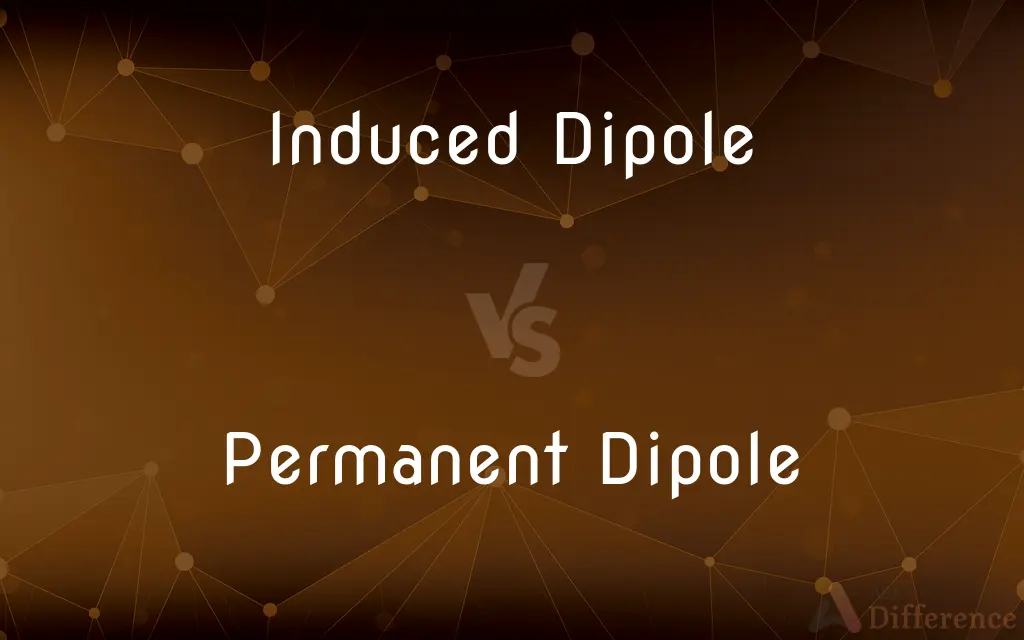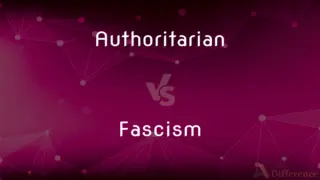Induced Dipole vs. Permanent Dipole — What's the Difference?
By Tayyaba Rehman — Published on November 4, 2023
An Induced Dipole is temporary and caused by external influences, while a Permanent Dipole inherently exists in molecules due to asymmetry.

Difference Between Induced Dipole and Permanent Dipole
Table of Contents
ADVERTISEMENT
Key Differences
Induced Dipoles and Permanent Dipoles both refer to charges within molecules, but they arise for different reasons. An Induced Dipole refers to a temporary charge that results from the influence of neighboring charged species. This means the dipole is formed due to external forces acting on a molecule, making its electron cloud shift.
On the contrary, a Permanent Dipole is inherent in certain molecules. This means that due to the difference in electronegativity between atoms in a molecule, there exists a permanent charge difference, giving rise to the dipole. Unlike the Induced Dipole, which is temporary and can change, the Permanent Dipole is consistent and fixed in the molecule.
It's essential to understand the significance of both these dipoles in molecular interactions. The presence of an Induced Dipole can lead to weak attractions known as London dispersion forces, especially in non-polar molecules. These forces can be relatively weak but become significant in larger molecules or atoms.
Permanent Dipoles, however, result in much stronger dipole-dipole interactions. These interactions are due to the inherent polarity in molecules, which leads to attractions between opposite charges in neighboring molecules. Both Induced and Permanent Dipoles play a crucial role in determining the physical properties of substances, like their boiling and melting points.
Comparison Chart
Origin
Caused by external influences
Inherent in molecules due to asymmetry
ADVERTISEMENT
Duration
Temporary
Permanent
Resultant Force
London dispersion forces
Dipole-dipole interactions
Dependence on Size/Shape
Increases with larger molecules/atoms
Depends on molecular asymmetry
Examples
Noble gases, non-polar molecules under influence
Water (H2O), Hydrogen fluoride (HF)
Compare with Definitions
Induced Dipole
A momentarily created dipole in non-polar substances.
When two helium atoms come close, an Induced Dipole might form.
Permanent Dipole
A consistent polarity present within polar molecules.
The Permanent Dipole in hydrogen fluoride results in strong intermolecular forces.
Induced Dipole
A fleeting dipole moment not intrinsic to a molecule.
Methane, under certain conditions, can exhibit an Induced Dipole.
Permanent Dipole
A molecule's intrinsic charge distribution not influenced by external factors.
The Permanent Dipole in HCl is responsible for its polarity.
Induced Dipole
A temporary charge imbalance in a molecule due to external influences.
In noble gases, an Induced Dipole can lead to weak attractions.
Permanent Dipole
An inherent charge imbalance within a molecule due to electronegativity differences.
Water molecules have a Permanent Dipole because of the O-H bonds.
Induced Dipole
The result of external forces acting on a molecule's electron distribution.
In a clump of argon gas, Induced Dipoles play a role in holding the atoms together.
Permanent Dipole
A lasting dipole moment arising from molecular structure.
Ammonia's structure gives it a Permanent Dipole.
Induced Dipole
An ephemeral polarity arising from shifting electron clouds.
The presence of a neighboring charged molecule can lead to an Induced Dipole.
Permanent Dipole
A stable dipole moment due to molecular asymmetry.
The uneven distribution of electrons in water results in a Permanent Dipole.
Common Curiosities
How does a Permanent Dipole differ from an Induced Dipole?
A Permanent Dipole inherently exists in a molecule, while an Induced Dipole is temporary and externally influenced.
Are Induced Dipole forces strong?
Generally, Induced Dipole forces, like London dispersion forces, are weaker than Permanent Dipole interactions.
How does molecule size affect Induced Dipoles?
Larger molecules or atoms can have stronger Induced Dipoles due to their larger electron clouds.
Can non-polar molecules have dipoles?
Non-polar molecules don't have Permanent Dipoles but can exhibit Induced Dipoles under certain conditions.
Is water an example of Permanent Dipole?
Yes, water has a Permanent Dipole due to the difference in electronegativity between hydrogen and oxygen.
What's the significance of dipoles in chemistry?
Both types of dipoles play crucial roles in determining molecular interactions, boiling points, and melting points.
Are all polar molecules Permanent Dipoles?
Yes, polar molecules inherently possess Permanent Dipoles.
What causes an Induced Dipole?
An Induced Dipole is caused by the influence of neighboring charged species or molecules.
Can a molecule have both types of dipoles?
A molecule with a Permanent Dipole can still have an Induced Dipole under certain conditions.
Why is the dipole moment essential?
It gives insights into a molecule's polarity, which impacts its interactions, solubility, and reactivity.
Do dipoles affect a substance's state?
Yes, they play a role in determining whether a substance is solid, liquid, or gas at a given temperature.
Is a Permanent Dipole always fixed?
While it's inherent to the molecule, its orientation can change in the presence of an electric field.
What happens to Induced Dipoles when external influences are removed?
The Induced Dipole disappears, and the molecule returns to its original state.
Can an Induced Dipole be measured?
While challenging, it can be indirectly inferred from molecular interactions and forces.
Which type of dipole is more common in nature?
Both are common, but Permanent Dipoles are inherent to polar molecules, while Induced Dipoles can occur in various conditions.
Share Your Discovery

Previous Comparison
Smart TV vs. Normal TV
Next Comparison
Authoritarian vs. FascismAuthor Spotlight
Written by
Tayyaba RehmanTayyaba Rehman is a distinguished writer, currently serving as a primary contributor to askdifference.com. As a researcher in semantics and etymology, Tayyaba's passion for the complexity of languages and their distinctions has found a perfect home on the platform. Tayyaba delves into the intricacies of language, distinguishing between commonly confused words and phrases, thereby providing clarity for readers worldwide.












































